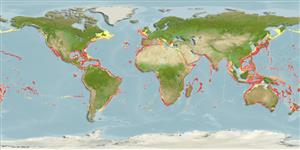Environment: milieu / climate zone / depth range / distribution range
Écologie
marin benthopélagique; océanodrome (Ref. 51243); profondeur 100 - 975 m (Ref. 9302), usually 200 - 400 m (Ref. 6181). Subtropical; 55°N - 43°S, 180°W - 180°E (Ref. 6181)
Circumtropical and temperate seas of the world.
Taille / Poids / Âge
Maturity: Lm ? range ? - ? cm
Max length : 300 cm TL mâle / non sexé; (Ref. 5951); common length : 150 cm SL mâle / non sexé; (Ref. 6181); poids max. publié: 63.5 kg (Ref. 4699)
Épines dorsales (Total) : 13 - 15; Rayons mous dorsaux (Total) : 15 - 18; Épines anales: 0; Rayons mous anaux: 15 - 18; Vertèbres: 32. Skin very rough, scales interspersed with spinous bony tubercles. Mid-ventral (abdominal) keel on the ventral contour. Body is uniformly brown to dark brown, tips of the pectoral and pelvic fins black, margins of the second dorsal and anal fins white in young specimens.
Usually over the continental shelf, sometimes in oceanic waters down to 800 m (Ref. 9302). Usually solitary or in pairs near the bottom (Ref. 6181). Migrates far offshore (Ref. 26139). Pelagic (Ref. 5951). Feeds on fish, crustaceans and squid (Ref. 6181). The peculiar wooden 'palu' or Ruvettus hook is used to catch this species in south central Pacific (Ref. 6181). The flesh is very oily, with purgative properties, if eaten much (Ref. 6181). Marketed fresh and as fish cakes in Japan (Ref. 9302); also processed into fishmeal (Ref. 5217). Maximum length reported to reach up to 2 m only (Heemstra, pers. comm. 03/03).
Life cycle and mating behavior
Maturities | Reproduction | Spawnings | Egg(s) | Fecundities | Larves
Nakamura, I. and N.V. Parin, 1993. FAO Species Catalogue. Vol. 15. Snake mackerels and cutlassfishes of the world (families Gempylidae and Trichiuridae). An annotated and illustrated catalogue of the snake mackerels, snoeks, escolars, gemfishes, sackfishes, domine, oilfish, cutlassfishes,. scabbardfishes, hairtails, and frostfishes known to date. FAO Fish. Synop. 125(15):136 p. (Ref. 6181)
Statut dans la liste rouge de l'IUCN (Ref. 130435)
Menace pour l'homme
Poisonous to eat (Ref. 4690)
Utilisations par l'homme
Pêcheries: intérêt commercial mineur; pêche sportive: oui
Outils
Articles particuliers
Télécharger en XML
Sources Internet
Estimates based on models
Preferred temperature (Ref.
123201): 8.6 - 19, mean 12.9 °C (based on 603 cells).
Phylogenetic diversity index (Ref.
82804): PD
50 = 1.0000 [Uniqueness, from 0.5 = low to 2.0 = high].
Bayesian length-weight: a=0.00347 (0.00191 - 0.00629), b=3.10 (2.93 - 3.27), in cm total length, based on LWR estimates for this species & (Sub)family-body (Ref.
93245).
Niveau trophique (Ref.
69278): 4.2 ±0.57 se; based on food items.
Résilience (Ref.
120179): Faible, temps minimum de doublement de population : 4,5 à 14 années (Assuming tm>4).
Prior r = 0.28, 95% CL = 0.19 - 0.42, Based on 1 data-limited stock assessment.
Fishing Vulnerability (Ref.
59153): Very high vulnerability (90 of 100).
Climate Vulnerability (Ref.
125649): Moderate vulnerability (38 of 100).
Nutrients (Ref.
124155): Calcium = 17.3 [7.8, 32.2] mg/100g; Iron = 0.573 [0.271, 1.108] mg/100g; Protein = 17.7 [15.5, 19.7] %; Omega3 = 0.202 [0.110, 0.353] g/100g; Selenium = 81.8 [36.6, 171.9] μg/100g; VitaminA = 10.3 [3.2, 36.7] μg/100g; Zinc = 0.411 [0.288, 0.611] mg/100g (wet weight);
